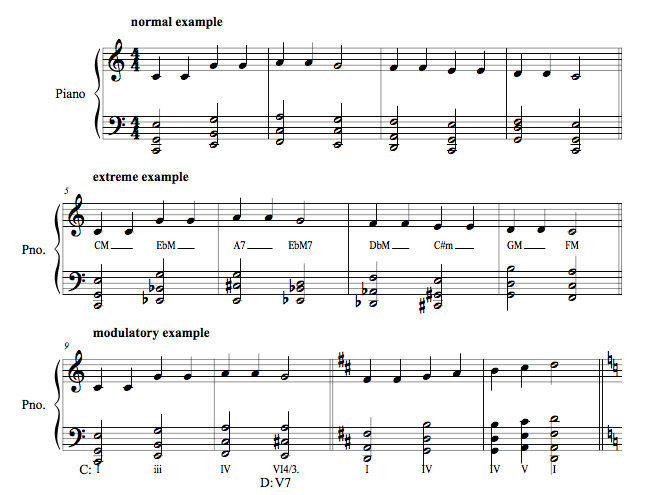Search the Community
Showing results for tags 'saturation'.
-
Instructor: @Monarcheon Students Allowing: 7 Initial Writing Requirement: use as many bars necessary, piano Initial Writing Requirement Deadline: April 20th Special Writing Requirement: use and label all 3 techniques In the second of these harmonic technique series, it's going to focus a lot on modulation and phrase alteration. These are good for keeping your audience guessing, and can easily grow and come back from a developing arc, at least harmonically. These are: Saturation (chromatic or diatonic) Direct/phrase modulations Reharmonization Saturation is a way of using all the tones in either a chromatic or diatonic scale before moving on with the phrase. A lot of you might refer to Schoenberg's twelve tone rows, but chromatic saturation has been used a lot before that, in pieces by Hugo Wolf. Mozart even attempted this kind of writing in the fourth movement of Symphony No. 40, KV. 550, in G minor, right before the development starts. Chromatic saturation is simply using all of the notes of the 12 tone spectrum within a segment of music. Here's the Mozart example from before: https://www.youtube.com/watch?v=B5fqVYXVDwU#t=03m30s It creates a perfect location to start a new phrase in a completely new place (the V/V of the key) from the III. Chromatic saturation doesn't all have to be in a row, though. Connecting strings of chromatic chords can achieve the same goal. Diatonic saturation is the same concept of chromatic saturation, but using a scale (any mode) as the grounds of saturation rather than chromaticism. Especially when combined into chords, this method can sound very cacophonous, but still tonal, as the composer resolves the mass of sound into a new phrase. An example from Rautavaara's "Cauntus Articus" https://www.youtube.com/watch?v=TO3YRZWLvQo#t=04m12s Direct modulations are basically modulations that don't really seem to fit within any traditional tonal analysis. The most common type of this is in pop, musical theatre, or rock music where the key moves up a whole or half step without warning to give the sense of harboring more energy in the song, especially with a repeated motif. Phrase modulations, can be direct modulation, but simply happen in the middle of a phrase to jar the audience, but still stay fluid throughout, most often by keeping a melody or inner voice in constant motion throughout the phrase. Phrase modulations are especially useful in recapitulations of sonata format, or when a repeated figure in any form of music is getting to be a little bit too much. Executing these may seem counter-intuitive, but it requires you to think outside of the realm of diatonicism in one key. If you compare the key of the phrase you're in and the key of the phrase you want to end in, the composition of phrase modulation is "how am I going to bridge those gaps?". Common ways, as said before, can be: ...keeping the melody/inner voice moving, and using accidentals to reach the new key. Ending a phrase in the original key, and instead of ending the melody where the the audience expects it diatonically, make the last note an accidental in the old key, but perfectly fine in the new key. Reharmonization is simply a way of taking a melody and changing the chords underneath it to make it sound new and different. An easy way to do this is take your melody, and find chords that it also sounds good with; sometimes these will be diatonic, sometimes they won't. Oftentimes, to make the new progression sound smooth, composers employ extended chords to help, having the melody end on 9th's, 11th's, or 13th's, so the bass line can move without sounding too jarring. This technique is also good in recapitulations or repeated figures. Using it can also be a great pivot for a modulation.
- 17 replies
-
- modulation
- masterclass
-
(and 2 more)
Tagged with:



